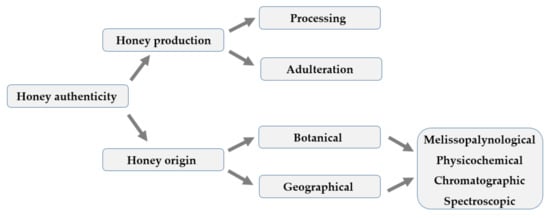Honey is a functional, honeybee product with a useful role in human nutrition and several health benefits. Greece is a Mediterranean region with several types of monofloral honey. Today, Greek honey has acquired an important position in national and international markets. Due to this increased industrialization and globalization, quality control is a necessity. Mislabeling constitutes one of the most notable types of fraudulence, while most consumers are looking for authentic honey. Moreover, producers and suppliers are searching for rapid and analytical methodologies to secure Greek honey in a competitive environment. In this entry, the classical (melissopalynological, physicochemical) and analytical (chromatographic, spectrometric, and spectroscopic) methods for the standardization of the botanical origin of Greek honey will be described.
Honeybees are an important group of insect pollinators; while they produce various bee products, honey is the most well-known. Since ancient times, honey constitutes the only sweetening product that can be stored and used exactly as produced in nature, a fact that makes it very important in terms of its authenticity. Practically, all types of honey are authentic and only human activity can affect them.
From a legal viewpoint, the European council directive (2001/110/EC)
[1] defines honey as,
“the natural sweet substance produced by Apis mellifera L. bees from the nectar of plants of from secretions of living parts of plants or excretions of plant-sucking insects on the living parts of plants, which the bees collect transform by combining with specific substances of their own, deposit, dehydrate, store and leave in honeycombs to ripen and mature”. Additionally, composition criteria including physicochemical characteristics according to main types of origin (blossom or honeydew), production, and/or presentation (comb, chunk, drained, extracted, pressed, filtered, and baker’s honey).
According to the literature during 1963–2017, in countries around the Mediterranean Basin, a total of 336 species of wild bees and honeybees and 54 beekeeping plants families were approximately estimated
[2]. Greece is mainly inhabited by four common
Apis mellifera L. subspecies namely
A.m. cecropia in central and southern Greek mainland,
A.m. carnica in Ionian Islands,
A.m. adami in Crete and southern Aegean, and
A.m. macedonica in Macedonia, Thrace, and parts of Thessaly and Epirus (
Figure 1)
[3].
Figure 1. Four common Apis mellifera L. subspecies in the Greek region.
Beekeeping plants provide nectar, honeydew, and/or pollen to honeybees. “Blossom honey” is produced from flower nectar, while “honeydew honey” is from honeydew secretions from insects parasitizing the plants; various mixtures are also produced. The period when a plant provides food is called the “flowering period”. Greece has a wide variety of indigenous and nonindigenous melliferous plants. The most common botanical species producing monofloral honeys in Greece are included in
Table 1. Greek legislation has set more strict criteria (
Table 2) compared to the European legislation regarding the eight most common monofloral honeys
[4].
Table 1. Melliferous species and honeys in Greek region.
| Scientific Name |
Flowering Period |
Nectar |
Pollen |
Honeydew |
Honey Name |
Commercially Widespread |
| Blossom Honeys |
| Arbutus unedo L. |
November–December |
3 * |
2 |
- |
Strawberry tree |
+ ** |
| Castanea sativa Miller |
June |
2–3 |
3 |
1–2 |
Chestnut |
++ |
| Ceratonia siliqua L. |
September–October |
3 |
3 |
2 |
Carob |
+ |
| Citrus spp. |
March–April |
3 |
2 |
- |
Citrus, orange etc. |
++ |
| Erica arborea L. |
October–November |
2–3 |
2–3 |
- |
Spring Heather |
++ |
| Erica manipuliflora Salisb. |
March |
3 |
2–3 |
- |
Autumn Heather |
++ |
| Eucalyptus spp. |
May–July |
2–3 |
2–3 |
- |
Eucalyptus |
+ |
| Gossypium hirsutum L. |
July–September |
|
- |
- |
Cotton |
++ |
| Helianthis annuus L. |
June–August |
2–3 |
2–3 |
- |
Sunflower |
+ |
| Paliurus spina-christi Miller |
May–June |
2–3 |
2 |
- |
Jerusalem thorn |
+ |
| Phlomis spp. |
|
2–3 |
- |
- |
Jerusalem sage |
+ |
| Pimpinella anisum L. |
|
1–2 |
1–2 |
- |
Anise |
+ |
| Polygonum aviculare L. |
July–August |
2 |
2 |
- |
Common knotweed |
+ |
| Salvia officinalis L. |
|
2–3 |
2 |
- |
Sage |
+ |
| Thymbra capitata L. |
June–July |
2–3 |
2 |
- |
Thyme |
+++ |
| Honeydew Honeys |
| Abies cephalonica Link. |
May–July |
- |
- |
3 |
Fir |
++ |
| Pinus spp. |
March–April, June–August, September–October |
- |
- |
3 |
Pine |
+++ |
| Quercus spp. |
|
- |
3 |
3 |
Oak |
+ |








